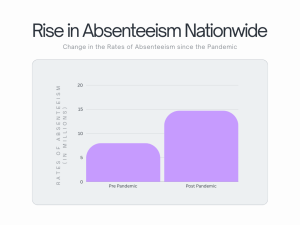On Friday, January 19th, while many students walked to the parking lot ready to enjoy the start of the weekend, a large group of people were getting their I.D.s ready outside the cafeteria, ready for yet another long afternoon of attendance recovery.
This problem isn’t unique to Paschal; according to the U.S. Department of Education website, chronic absenteeism affects schools nationwide and has increased in recent years.
The U.S. Department of Education defines chronic absenteeism as missing at least fifteen days over one school year. Being chronically absent can harm students’ education and their adult life. According to the U.S. Department of Education website, chronic absenteeism significantly increases the risk of high school dropout, which “has been linked to poor outcomes later in life, from poverty and diminished health to involvement in the criminal justice system.”

According to Paschal’s assistant principal, Ms. Leavitt, chronic absenteeism is mainly a problem at Paschal because of block scheduling.
“From a student perspective,” Ms. Leavitt continues, “missing class is a problem because students have the potential to miss so much due to our 95-minute class periods.”
Data suggests that the COVID-19 pandemic had a detrimental impact on attendance. According to the Attendance Works Website, attendance nationwide had doubled from 8 million students before the pandemic to 14.7 million afterward.
Ms. Leavitt says that for Paschal, the main change due to COVID-19 was that students were allowed to make up unlimited hours of missed online classes during the pandemic. Many students got used to having a lot of attendance recovery available. However, the policy has changed, and students must now be present for at least 75 percent of the time to make up unappealed absences with attendance recovery.
“You can see what percentage you’re at on the sheet in focus,” Ms. Leavitt says.
This leads to another important point: previously when students turned in a doctor’s note for absences due to illness or an appointment, they were automatically forgiven so students wouldn’t have to make them up. Now, students must turn in a separate appeal form, which can be obtained from the attendance office or the Paschal website. Ms. Leavitt encourages students always to turn in an appeal if they have been absent for a long time.

A lot of this information can also be found on the attendance sheet. According to Ms. Leavitt, students must check the sheet because they could still need attendance recovery even if they haven’t missed more than four days. To get credit for a class, students need to be there for ninety percent of the time–if their schedule was changed relatively late in the year, they might not be able to miss four days to meet ninety percent.
Overall, Paschal might be doing better than many schools in the country regarding attendance. “Paschal doesn’t have the worst rates of absenteeism in Fort Worth ISD,” Ms. Leavitt says. “But we would obviously always like it to be better.”






